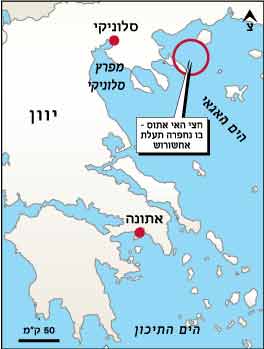In 480 BC, King Ahasuerus of Persia ordered his men to build a canal two kilometers long, which would cross the Athos peninsula in northern Greece. This operation was, it seems, one of the largest engineering enterprises of that time.

Seismic methods enabled the discovery of the ancient canal
By Yudhijit Bhattacharjee' New
York Times, Haaretz
Archeology
In 480 BC, King Ahasuerus of Persia ordered his men to build a canal two kilometers long, which would cross the Athos peninsula in northern Greece. This operation was, it seems, one of the great engineering enterprises of that time.
The canal was essential for King Ahasuerus' invasion of Greece. 12 years
Earlier the Persians tried to do this, without success. Ahasuerus was
Believes, apparently, that the construction of the canal will make it possible to move the ships of the fleet without
to withstand the threat of drowning during a storm at sea.
Ahasuerus did invade Greece that year, and began a short period of conquest
Persian in Europe. In the 2,500 years since then, historians are divided
In their opinion, if the famous Achshorosh canal was actually dug in its entirety, from the coast of El
Beach of the peninsula. Some of them doubted its existence, and claimed that the existence of
A rocky plain on the peninsula would have made the construction of the canal an impossible task
Possible, considering the technical capabilities that the prizes had.
Now researchers from Great Britain and Greece have discovered findings that, according to them, constitute evidence
Unequivocal that the canal was indeed built in the fifth century BC.
Relying on geological information collected several meters below the ground surface, there
Burial on the day of the canal, the researchers were able to draw a kind of map that details the
The dimensions of the canal and its location.
The width of the canal was about 35 meters on the surface, and it allowed the passage of
Two warships together. Its sides were sloped inwards, like this
which at the bottom was about 17 meters wide. The depth of the trench was 15 meters below
before the ground.
"It was a tremendous operation," said Dr. Ben Iserlin, an archaeologist
at the University of Leeds who started the research project on the canal in the early years
The '90s didn't have wheels then. The workers would fill baskets with soil
and pass them on from one person to another, and so all the way up to the top."
Mapping the canal was also a complicated operation. Dr. Richard Jones, the researcher
The head of the project and an archaeologist at the University of Glasgow, and his research colleagues,
Use a seismic method that is usually used in oil drilling
and minerals. In this method, you hit a piece of metal that is placed on a heavy hammer
the ground. The impact creates ripples that spread downwards, into the ground. the researchers
They analyzed the time it takes for the waves to return to the surface, and thus were able to draw a diagram
Seismic diagram of the buried trench.
"The structure is too large to be characterized using techniques
Ordinary archaeologies," said Dr. Vassilis Krastathis, a member of the team
who carried out the seismic and geophysical research at the National Observatory of Athens.
The team's findings were recently reported in the Journal of Applied
Geophysics The trench structure, as sketched by the geophysical team,
Confirmed by analyzing sediment samples taken from different depths.
The canal, buried under sediments accumulated over centuries, is evidence
For military strategy, personnel management and civil engineering at an impressive level.
The building also tells about short-sightedness and haste, and about a king who apparently
He was in such a hurry to conquer that he did not give his opinion on preserving the canal as a water crossing
Permanent.
"From the analysis of the sediments in the canal, we know that it was probably not extended
days," said Jones. "The Persians did not think of it as a structure that would last
Hundreds of years. As soon as their ships passed, it was a storm."
Dr. Maria Brosius, researcher of ancient history at the university
Newcastle, said the canal demonstrates engineering capabilities that existed before
before the time of Ahasuerus. "The ability to build such a structure existed
Since the days of the kingdom of Babylon and the kingdom of Assyria," said Brosius.
